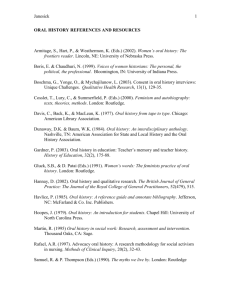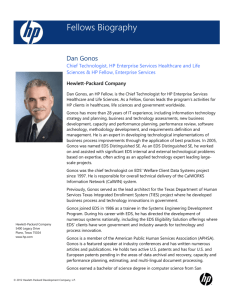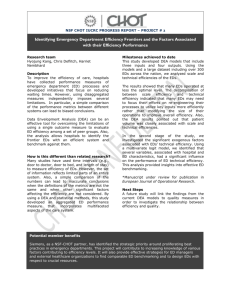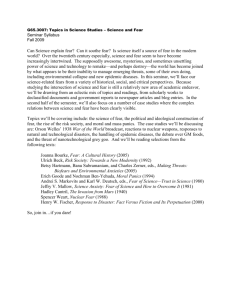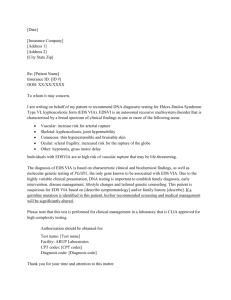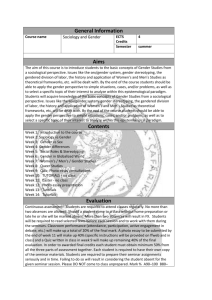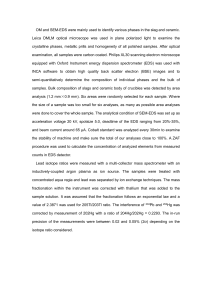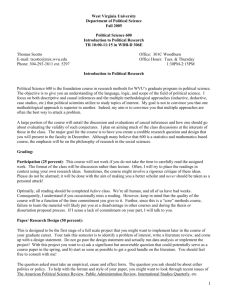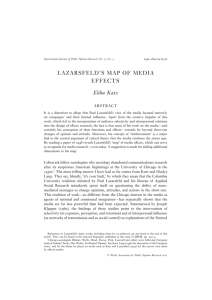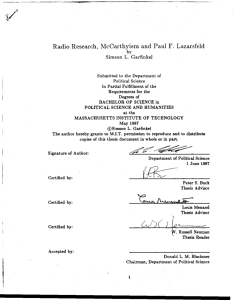Communication Theory (526)
advertisement
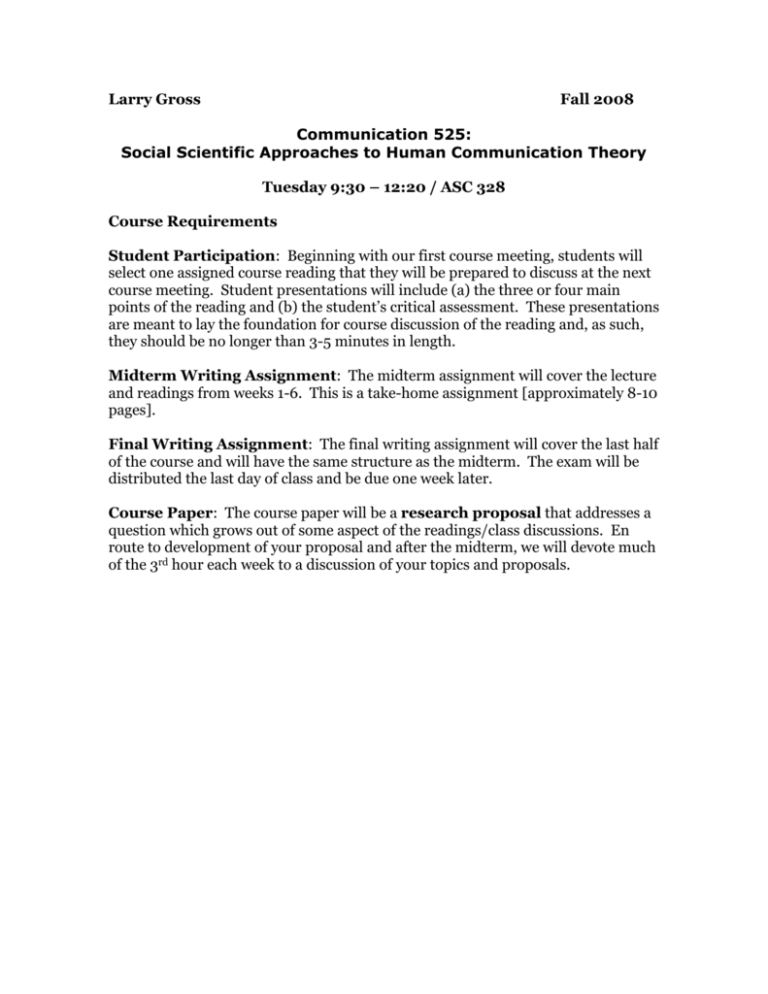
Larry Gross Fall 2008 Communication 525: Social Scientific Approaches to Human Communication Theory Tuesday 9:30 – 12:20 / ASC 328 Course Requirements Student Participation: Beginning with our first course meeting, students will select one assigned course reading that they will be prepared to discuss at the next course meeting. Student presentations will include (a) the three or four main points of the reading and (b) the student’s critical assessment. These presentations are meant to lay the foundation for course discussion of the reading and, as such, they should be no longer than 3-5 minutes in length. Midterm Writing Assignment: The midterm assignment will cover the lecture and readings from weeks 1-6. This is a take-home assignment [approximately 8-10 pages]. Final Writing Assignment: The final writing assignment will cover the last half of the course and will have the same structure as the midterm. The exam will be distributed the last day of class and be due one week later. Course Paper: The course paper will be a research proposal that addresses a question which grows out of some aspect of the readings/class discussions. En route to development of your proposal and after the midterm, we will devote much of the 3rd hour each week to a discussion of your topics and proposals. Communication 526 Fall 2008 2 COURSE LECTURE AND READING TOPICS 1. August 26: Nothing Never Happens 1. Edward Hall, The Silent Language [Anchor books, 1959], Chapters 3 [The vocabulary of culture], 4 [The Major Triad], 5 [Culture is Communication], & Appendix II, pp. 33-101, 186-194. 2. Larry Gross, “Modes of communication and the acquisition of symbolic competence,” David Olson, ed. Media and Symbols: The Forms of Expression, Communication and Education, [NSSE, 1974], pp. 56-80. 3. James Carey, “A cultural approach to communication,” Communication and Culture [Unwin Hyman, 1989], pp.36. 2. September 2: Reading People and Messages 1. Erving Goffman, The Presentation of Self in Everyday Life [Anchor, 1959], Introduction, Chapter 1 [Performances], & 7 [Conclusion], pp. 1-77, 238255. 2. Larry Gross, “Life vs. Art: The Interpretation of Visual Narratives,” Studies in Visual Communication, 11:4, 1985, pp. 2-11. 3. September 9: Mass Mediated Culture 1. Peter Berger, The Sacred Canopy: Elements of a sociological theory of religion [Anchor, 1967], Chapter 1 [Religion and World-Construction] & 2 [Religion and World-Maintenance], pp. 3-51. 2. George Gerbner, Larry Gross, Michael Morgan and Nancy Signorielli, “Growing up with television: Cultivation Processes,” J Bryant and D Zillmann, eds. Media Effects: Advances in Theory and Research, 2nd edition [Erlbaum, 2002], pp,43-67. 3. L. J. Shrum, “Media consumption and perceptions of social reality: Effects and underlying processes,” J Bryant and D Zillmann, eds. Media Effects: Advances in Theory and Research, 2nd edition [Erlbaum, 2002], pp. 69-95. 4. Helena Bilandzic, “The perception of distance in the cultivation process: A theoretical consideration of the relationship between television content, processing experience, and perceived distance,” Communication Theory, 2006, Vol. 16, pp. 333-355. 5. Jeffrey Jones, Entertaining Politics: New political television and civic culture [Rowman and Littlefield, 2005], “Rethinking engagement in the age of popular culture,” pp. 15-32. 4. & 5. September 16 & 23: Culture as Industry and Ideology 1. Max Horkheimer and Theodor Adorno, “The culture industry: Enlightenment as mass deception,” in Dialectic of Enlightenment [1944; Herder and Herder 1972], pp. 120-167]. Communication 526 Fall 2008 3 2. John Durham Peters, “The subtlety of Horkheimer and Adorno: Reading ‘The culture industry,” Elihu Katz, et. Al., eds. Canonic Texts in Media Research [Polity, 2003], pp. 58-73 3. Raymond Williams, “Base and Superstructure in Marxist Cultural Theory,” [1973] in Problems in Materialism and Culture [Verso, 1980], pp. 31-49. 4. Stuart Hall, “Encoding/decoding,” Stuart Hall, et. Al., eds. Culture, Media, Language: Working Papers in Cultural Studies 1972—79 [Hutchinson, 1980], pp. 128-137. 5. Michael Gurevitch & Paddy Scannell, “Canonization Achieved? Stuart Hall’s ‘Encoding/decoding,’” Elihu Katz, et. Al., eds. Canonic Texts in Media Research [Polity, 2003], pp. 231-247. 6. Stuart Hall, “The rediscovery of ‘ideology’: The return of the repressed in media studies,” Michael Gurevitch, et. Al., eds. Culture, Society and the Media [Methuen, 1982], pp. 56-90. 7. Paul Lazarsfeld, “Administrative and critical communications research,” J D Peters and Peter Simonson, eds. Mass Communication and American Social Thought: Key Texts, 1919 – 1968 [Rowman and Littlefield, 2004], pp. 166-173. 8. Pierre Bourdieu, “Introduction,” Distinction: A social critique of the judgement of taste [Harvard, 1984], pp. 1-7. 6. & 7. September 30 & October 7: Publics, Opinions and Public Opinion 1. Gabriel Tarde, “Opinion and Conversation,” in Tarde on Communication and Social Influence: Selected Papers [1898, Chicago, 1969] pp. 297 - 324. 2. Elihu Katz, “On parenting a paradigm: Gabriel Tarde’s agenda for opinion and communication research,” International Journal of Public Opinion Research, 1991, 80-86. 3. Elihu Katz and Paul Lazarsfeld, “Between media and mass,” from Personal Influence, J D Peters and Peter Simonson, eds. Mass Communication and American Social Thought: Key Texts, 1919 – 1968 [Rowman and Littlefield, 2004], pp. 358 - 364. 4. Elihu Katz, “Lazarsfeld’s Legacy: The Power of Limited Effects,” Preface to the Transaction Edition of Personal Influence, [Transaction Books, 2006], pp. xv-xxvii]. 5. Carroll Glynn, et. al., “Opinions, perception and social reality,” Theodore Glasser and Charles Salmon, eds., Public Opinion and the Communication of Consent [Guilford, 1995], pp. 249- 277. 6. Elizabeth Noelle-Neumann, “The spiral of silence: A Theory of public opinion,” Journal of Communication, 1974, pp. 44-51. 7. Christopher Simpson, “Elizabeth Noelle-Neumann’s ‘Spiral of silence’ and the historical context of communication theory,” Journal of Communication, 1996, 46, pp. 149 – 172. 8. W. Phillips Davison, “The Third-Person Effect in Communication,” Public Opinion Quarterly, 1983, 47, pp. 1-15. Communication 526 Fall 2008 4 9. Richard Perloff, “The third-person effect,” J Bryant and D Zillmann, eds. Media Effects: Advances in Theory and Research, 2nd edition [Erlbaum, 2002], pp. 489-506. 10. Scott Reid and Michael Hogg, “A self-categorization explanation for the third-person effect,” Human Communication Research, 2005, 31:1, pp. 129161. 8. October 14: Fit to Print or Printing to Fit? 1. Daniel Boorstin, “From News Gathering to News Making: A flood of pseudo-events,” The Image or What Happened to the American Dream? [Athaneum, 1962], pp. 7-44. 2. Gaye Tuchman, “News and Frame” and “News as the reproduction of the status quo,” Making News: A Study in the Construction of Reality [The Free Press, 1978], pp. 1-14, 209-217. 3. Todd Gitlin, “”Media routines and political crises,” The Whole World is Watching: Mass media in the making and unmaking of the new left [California, 1980], pp. 249- 282. 4. Edward Herman and Noam Chomsky, “A propaganda model,” in Manufacturing Consent: The political economy of the mass media [Pantheon, 1988], pp. 1-35. 5. Robert McChesney, “U.S. media at the dawn of the twenty-first century,” Rich Media, Poor Democracy [Illinois, 1999], pp. 15-77. 9. October 21: Disney’s World? 1. Daya Kishan Thussu, “Approaches to theorizing international communication,” International Communication: Continuity and Change [Arnold, 19 ], pp. 53-81 2. Toby Miller, et. al., Introduction and Conclusion, Global Hollywood 2 [BFI, 2005], pp. 1-49, 333-370. 3. Manuel Castells, “Conclusion: Making sense of our world,” End of Millenium; The Information Age: Economy, Society and Culture, VOL. 3 [2nd Edition, Blackwell, 2000], pp. 366-391. 4. Néstor García Canclini, “The North-South Dialogue on Cultural Studies” and “Twenty-first Century Consumers, Eighteenth-Century Citizens,” Consumers and Citizens: Globalization and Multicultural Conflicts [Minnesota, 2001], pp. 3-34. Communication 526 Fall 2008 GUEST LECTURES: DETAILS TO COME 10. October 21: 11. October 28: 12. November 4: 13. November 11: 14. November 18 15. November 25 16. December 2: 5
